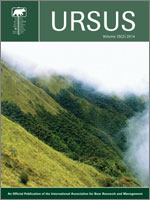The Andean bear (Tremarctos ornatus), the only extant ursid in South America, lives in páramo and montane forest ecosystems and is classified as vulnerable on the International Union for Conservation of Nature Red List (Goldstein et al. 2008). In Podocarpus National Park in southern Ecuador, Andean bears exhibit patchy foraging behavior on Puya eryngioides, a small terrestrial bromeliad. The objective of this study (conducted during summer 2011 in Podocarpus National Park) was to determine which factors influence foraging by characterizing and contrasting the biological and physical surroundings of foraged and unforaged P. eryngioides patches within a larger feeding site. The majority of our variables did not differ between foraged and unforaged patches at the measured scale, but we found evidence that foraging choices might be influenced by aspect, microtopography, P. eryngioides density, and distance from cover. These results provide a foundation for future research into food resources and foraging behavior by Andean bears, which is critical information for conservation in the changing and increasingly fragmented páramo ecosystem.
How to translate text using browser tools
1 October 2014
Selective foraging on bromeliads by Andean bears in the Ecuadorian páramo
Stephanie M. DeMay,
David A. Roon,
Janet L. Rachlow,
Rodrigo Cisneros
ACCESS THE FULL ARTICLE





